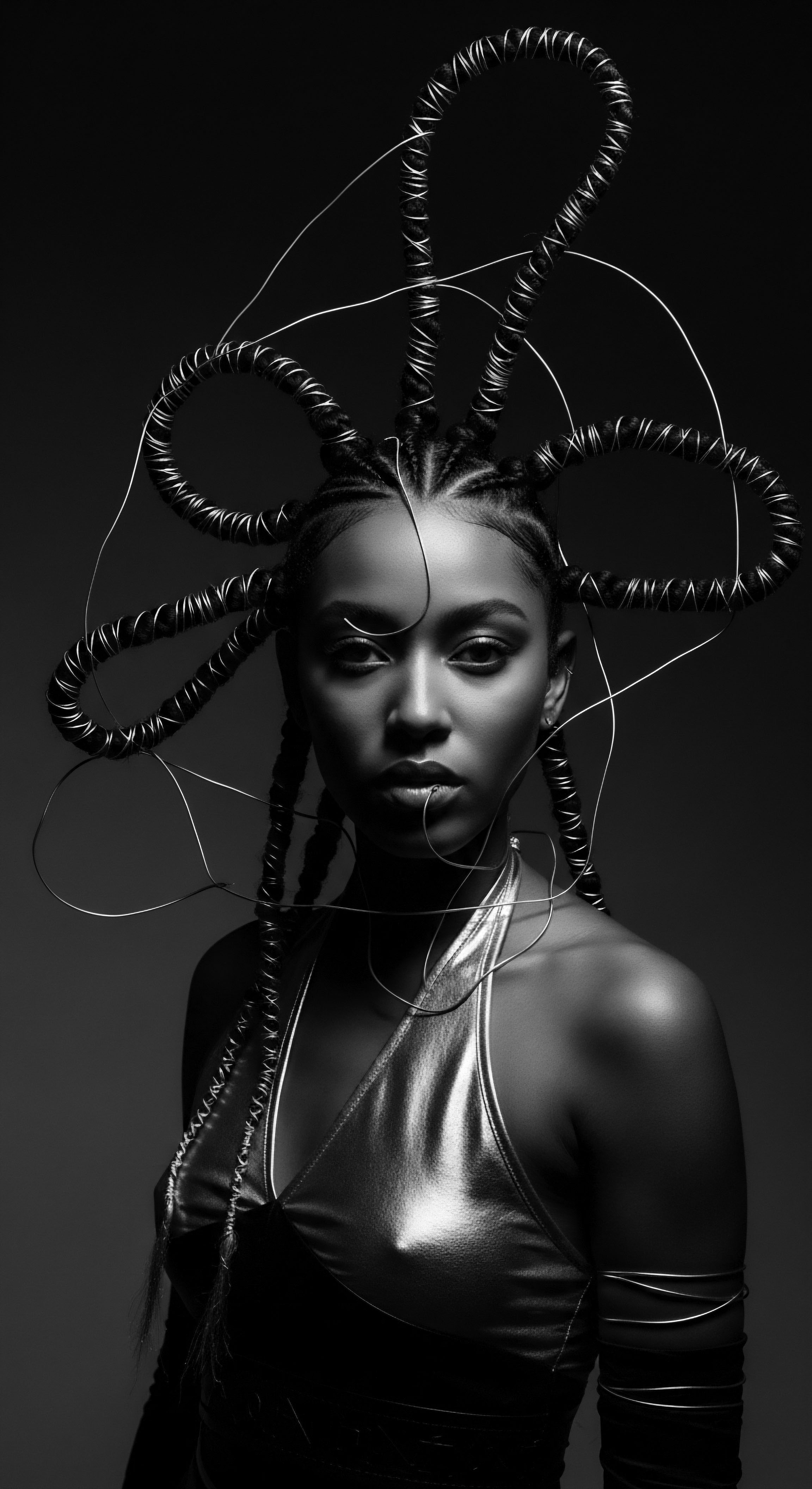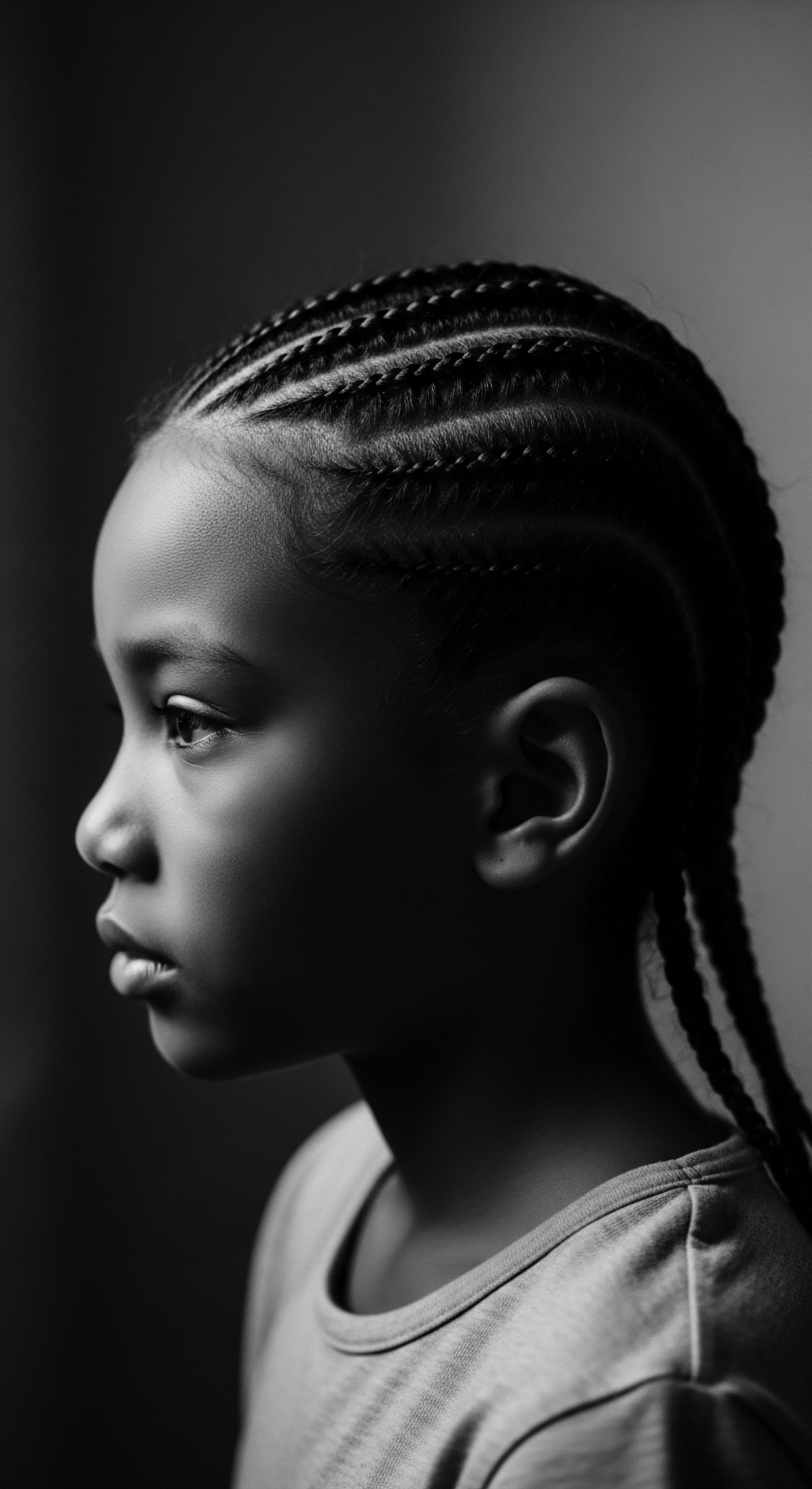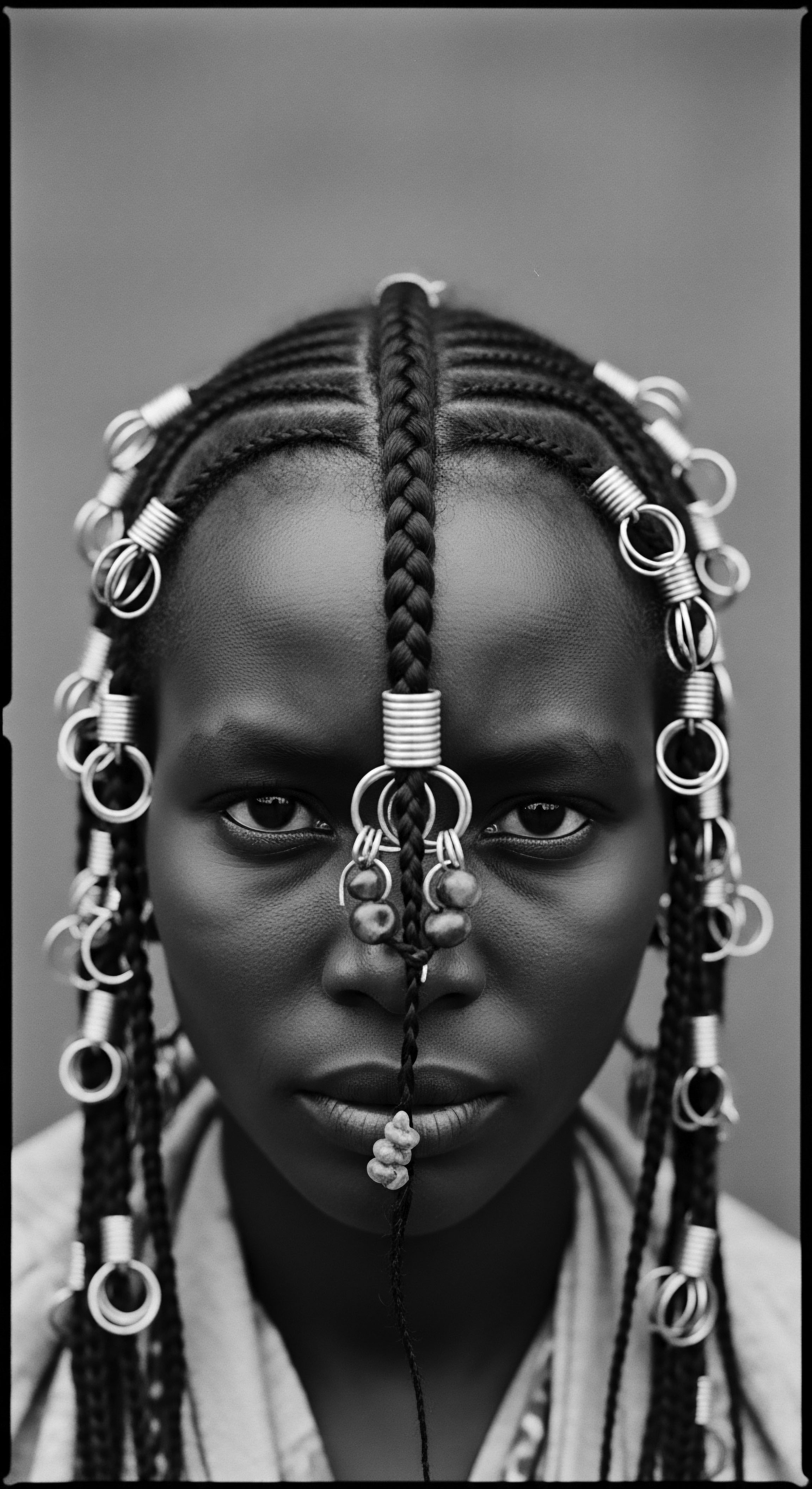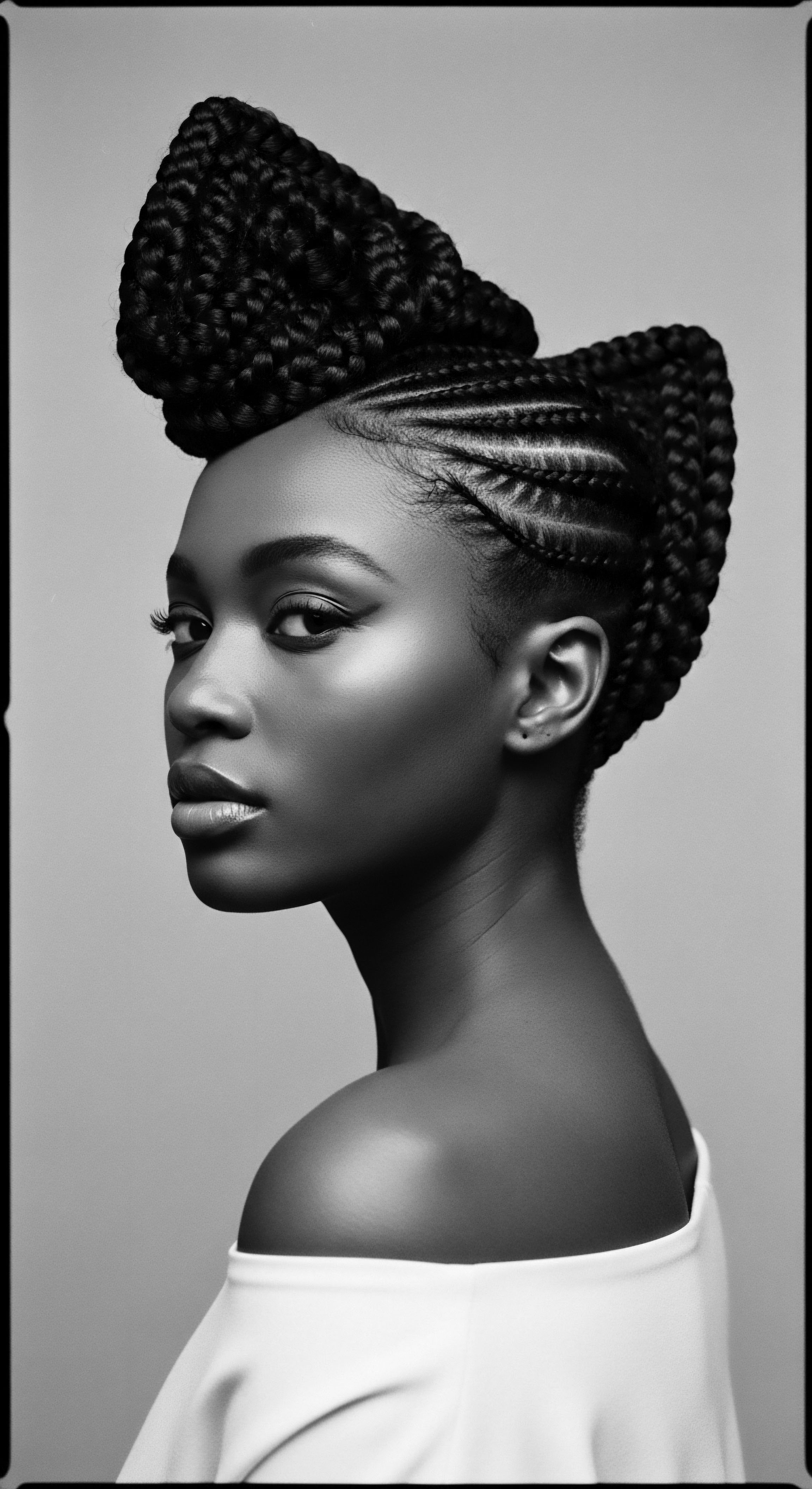
Roots
The sun’s insistent kiss upon our skin and hair has shaped human existence since the dawn of time, particularly for those whose lineage hails from sun-drenched lands. For textured hair, coils and curls that defy gravity and dance with light, this relationship with the sun is an ancient one, deeply woven into its very biological fabric. Our ancestral strands, magnificent in their spiraled architecture, offer a silent testament to generations who understood, long before modern science, how to live in concert with the elements. What historical styles offered natural sun defense for textured hair?
The inquiry guides us not merely to a list of historical practices, but into a profound dialogue with the wisdom keepers of old—the grandmothers, the community elders, the skilled hands that sculpted hair into statements of identity, status, and, crucially, protection. This journey into textured hair heritage is a homecoming, a reclamation of knowledge often sidelined in contemporary beauty narratives.
The very structure of Afro-textured hair, with its unique helical configuration, emerged as an evolutionary adaptation in ancient Africa to shield the scalp from intense ultraviolet radiation. The spiraled form, often dense in its appearance, permits air circulation, contributing to natural thermal regulation. This inherent biological defense was then augmented by ingenious styling methods and topical applications, transforming hair care into an art form and a practical necessity. The stories embedded within these styles speak volumes, reminding us that beauty has always served a greater purpose than mere aesthetics; it was a means of survival, a cultural marker, and a profound expression of communal and individual spirit.

Hair Anatomy and Its Ancestral Shield
Consider the biology of textured hair itself. Its elliptical follicle shape, leading to a curved hair shaft, causes those magnificent coils and curls. This morphology, when considered through an ancestral lens, presents a natural barrier. The density that many coiled patterns exhibit can act as a canopy, minimizing direct sunlight exposure to the scalp, a vulnerable area.
Evolutionary biologists propose that this unique structure was a primary adaptation against the scorching African sun, allowing for air to circulate while shielding the skin below. This innate protective quality of tightly coiled hair laid the foundation for human ingenuity in enhancing that defense.
Textured hair’s coiled structure provided an early, inherent defense against intense sunlight, a testament to ancestral adaptation.
Beyond the physical form, the hair’s natural oils, often more concentrated at the scalp due to the hair’s curl pattern, were, and remain, vital. While often perceived as a challenge in modern care routines, these oils, when nurtured, served as a natural sealant and a first line of defense against environmental stressors, including sun and wind. Ancestral practices understood this, developing regimens that worked with, rather than against, the hair’s natural inclinations, ensuring these protective qualities were preserved and enhanced.

Classifying Textured Hair from a Heritage View
While modern systems classify textured hair by types (e.g. 3A to 4C), our ancestors understood hair not through alphanumeric codes, but through its tactile feel, its response to moisture, and its appearance, linking it directly to identity and lineage. This traditional understanding was inherently holistic.
The classification was less about numerical assignment and more about recognizing variations within the community, appreciating each pattern’s unique requirements and inherent beauty. This traditional knowledge often guided specific styling choices for sun defense.
- Coiled Canopies ❉ Tightly coiled hair, offering natural density to shield the scalp.
- Patterned Protection ❉ Braids and twists, forming a physical barrier over individual strands and scalp.
- Oiled Resilience ❉ The natural inclination for scalp oils to remain close, providing a layer of external defense.

Words from the Textured Hair Journey
The lexicon of textured hair is as rich and varied as the hair itself, shaped by diverse cultures and historical experiences. Words like ‘braid,’ ‘twist,’ ‘loc,’ and ‘wrap’ carry centuries of meaning, each a testament to techniques born from necessity and artistry. In ancient West Africa, for instance, elaborate braided styles communicated not only social status and marital standing but also served as practical protection against the harsh sun and drying winds. These terms are not mere descriptions; they are echoes of ancestral hands, communal gatherings, and the enduring spirit of textured hair heritage.
When we consider sun defense, traditional terminologies for head coverings, such as the West African ‘gele’ or the Southern African ‘doek,’ signify far more than fabric. They denote cultural identity, spiritual observance, and a deliberate act of shielding hair and scalp from the elements. These words carry stories of resilience, of reclaiming identity, even in times of oppression.

Ritual
The dance between the human hand and textured hair has, across millennia, given rise to an incredible array of styles. These creations served myriad purposes, from signifying social standing to expressing spiritual devotion, but a pervasive, practical thread through many cultures was sun defense. Our ancestors, living in climates where the sun’s rays were a constant presence, mastered the art of styling hair to protect it, transforming daily routines into sacred rituals. How did historical styles transform sun defense into an art for textured hair?
It was a story told through the meticulous plaiting of braids, the careful wrapping of cloth, and the thoughtful application of natural emollients. These styles were not static; they evolved with communities, responding to climate, social structure, and available resources, always retaining their core purpose ❉ safeguarding the strands.

Protective Styling Beyond Aesthetics
Protective styles, a cornerstone of textured hair care today, possess a deep and complex lineage rooted in ancestral practices. These methods were engineered to minimize manipulation of the hair shaft, shield delicate ends, and, critically, offer a physical barrier against environmental stressors, including the sun’s potent ultraviolet radiation. Consider the enduring legacy of Braids and Twists. Dating back thousands of years in African civilizations, these styles—from intricate cornrows lying close to the scalp to voluminous box braids—encased the hair, preventing direct sun exposure to the length of the strands.
A powerful historical example of this comes from the Himba People of Namibia. For centuries, Himba women have created an iconic hairstyle using a mixture called Otjize, a blend of butterfat, red ochre, and aromatic resin. This deep red paste is applied daily to their intricate braided locks and skin. The otjize not only symbolizes beauty and cultural identity but also functions as a highly effective sun protectant, physically blocking UV rays and providing a rich moisturizing layer against the arid climate.
This practice, passed down through generations, powerfully illustrates how practical sun defense was intertwined with cultural expression and ancestral tradition. (Himba, 2020)
| Historical Method or Style Braids (e.g. Cornrows, Box Braids) |
| Mechanism of Sun Defense Hair strands are gathered and interlocked, creating a dense covering that reduces direct sun exposure to the scalp and hair shaft. Ends are often tucked away. |
| Modern Scientific Link Reduces surface area exposure to UV, minimizes photodegradation of keratin, and lessens moisture loss from direct sun. |
| Historical Method or Style Headwraps (Gele, Doek, etc.) |
| Mechanism of Sun Defense Fabric covering provides a physical barrier, absorbing or reflecting sunlight before it reaches the hair or scalp. |
| Modern Scientific Link Directly blocks UV radiation, similar to a hat, protecting both hair and scalp from sun damage. |
| Historical Method or Style Oils and Butters (Shea Butter, Coconut Oil, etc.) |
| Mechanism of Sun Defense Forms a protective layer on the hair shaft, sealing in moisture and potentially offering mild UV absorption or reflection. |
| Modern Scientific Link Certain natural oils possess inherent SPF properties (e.g. coconut oil, shea butter offering mild UV blocking). |
| Historical Method or Style Wigs (Ancient Egypt) |
| Mechanism of Sun Defense Provided a dense, often thick, layer of human or plant fibers over a shaven or cropped head. |
| Modern Scientific Link Acted as a physical shield, providing shade and protection, especially in hot climates where shaved heads were common. |
| Historical Method or Style These ancient solutions reveal a deep understanding of environmental challenges and hair preservation. |

Natural Definition Techniques for Environmental Resilience
Beyond braids, other natural styling techniques offered sun defense. Bantu Knots, originating from the Bantu people, are created by sectioning hair and twisting each strand tightly upon itself, forming compact buns close to the scalp. When carefully applied, these knots encapsulate sections of hair, safeguarding them from environmental assault while also promoting curl definition.
Similarly, twists of various sizes (like Senegalese twists or mini twists) provided a contained structure, reducing the hair’s overall surface area exposed to the sun and preventing tangling from wind, which can exacerbate dryness and breakage. These methods were not just about maintaining style; they were about maintaining health and longevity for textured hair in challenging climates.
Ancient practices of intricate styling provided both beauty and essential protection for textured hair against harsh environments.

Wigs, Head Coverings, and Hair’s Ancient Disguises
The use of wigs and head coverings represents another profound aspect of historical sun defense for textured hair. In ancient Egypt, where priestly traditions often necessitated shaved heads, wigs were not merely decorative status symbols; they were vital for protection from the intense sun. Crafted from human hair, plant fibers, or even wool, and often set with beeswax and resin, these elaborate headpieces provided a substantial barrier between the scalp and the sun’s rays. This practice highlights an early understanding of the need for scalp protection, especially when natural hair was absent or minimal.
Headwraps, in their myriad forms, stand as a powerful symbol of heritage and practical sun defense across the African diaspora and beyond. From the opulent ‘gele’ of West Africa to the vibrant ‘dhoop’ of East Africa, head coverings were, and remain, a versatile and significant means of shielding hair and scalp. These cloths, sometimes layered, provided shade and prevented moisture loss, especially in arid regions.
They became symbols of resilience during times of oppression, a way to maintain dignity and cultural identity even when natural hair was devalued. The intentionality behind selecting specific fabrics and wrapping styles demonstrates a deep, ancestral wisdom regarding environmental adaptation and personal well-being.

Relay
The continuum of care for textured hair, stretching from the earliest human settlements to our present moment, reveals a profound, unbroken chain of knowledge. Ancestral wisdom, often dismissed as folklore in academic circles, holds scientific validity and practical application, particularly in the realm of sun defense. What informed holistic hair care and problem-solving rooted in heritage and ancestral wisdom for sun defense?
It was a collective understanding that healthy hair, capable of withstanding the elements, arose from a regimen that nurtured both the physical strand and the spiritual self. This deep connection between wellness, environment, and beauty formed the bedrock of historical care practices, a legacy that continues to teach us.

Regimens for Sun Resilience from Ancestral Wisdom
The creation of personalized hair regimens is not a modern innovation. Ancestral communities cultivated highly specific care practices tailored to their environment and the particular qualities of their hair. These routines were often communal, passed down through oral tradition and practiced collectively. For sun defense, the emphasis was on deep conditioning and sealing moisture, recognizing that sun exposure leads to dryness and brittleness.
Traditional practices often involved the regular application of rich emollients. In West Africa, Shea Butter was, and still is, a cornerstone. This butter, extracted from the nuts of the shea tree, offers deep moisturization and possesses natural sun-blocking components, providing mild protection against UV rays. Similarly, in some parts of India, Coconut Oil was used to form a protective layer on the hair, guarding against the tropical sun and preventing moisture loss.
These natural ingredients were not just applied; they were massaged in, allowing for scalp stimulation and thorough conditioning, reflecting a holistic view of hair health. This intentional, consistent application built the hair’s resilience against solar radiation.
- Shea Butter ❉ A West African staple, providing UV protection and deep hydration for sun-exposed hair.
- Coconut Oil ❉ Used across Asia and Africa, this oil helps shield hair from sun and moisture loss.
- Red Ochre and Butterfat ❉ The Himba’s otjize, a vibrant paste that physically blocks the sun’s rays.
The ingenuity extended to the timing of these rituals. Nighttime became a sanctuary for hair restoration. After a day under the sun, hair would be cleansed and then saturated with oils or herbal concoctions, often wrapped to allow these remedies to work undisturbed. This not only repaired daily damage but also prepared the hair for the following day’s exposure, creating a continuous cycle of protection and restoration.

The Nighttime Sanctuary and Head Covering Wisdom
The ritual of nighttime hair care, particularly the use of head coverings, has deep roots in heritage, serving both practical and symbolic purposes. While modern bonnets and wraps are often associated with protecting styled hair and preventing breakage, their historical counterparts provided crucial elements of sun defense. During the day, scarves and headwraps functioned as a primary physical barrier against the sun’s harsh rays, allowing communities to navigate outdoor life. When not actively exposed, hair needed restoration.
After hours spent under the sun, often in labor or daily life, hair would inevitably experience moisture depletion and potential damage. Nighttime was when deep conditioning and restorative treatments took place. Hair, coated in nourishing oils or botanical infusions, would then be carefully wrapped, often in textiles of linen or cotton. This practice sealed in moisture, prevented tangling during sleep, and allowed the natural emollients to penetrate deeply.
It was a practice of replenishment, ensuring the hair remained supple and resilient, ready to withstand future environmental challenges. The simple act of wrapping the hair, both day and night, speaks to a consistent, protective regimen that prioritized hair integrity.

Addressing Hair Concerns with Ancient Solutions
Ancestral communities understood hair problems, including sun-induced damage, and developed comprehensive solutions long before pharmaceutical advancements. When considering how historical communities addressed issues like dryness, brittleness, or thinning exacerbated by sun exposure, their responses were remarkably scientific in their effectiveness, if not in their explicit articulation of chemical compounds.
For instance, the damage caused by UV radiation—leading to protein degradation and moisture loss in hair—was countered with protein-rich applications and intense hydration. Plants like Aloe Vera, widely used by Native American tribes, offered cooling relief for sunburned scalps and deep moisturizing properties for the hair shaft, helping to shield it from sun and harsh weather. The practice of using specific clays, like those found in the Himba’s otjize, acted as physical blockers, reflecting UV light away from the hair and skin, a principle now understood in modern mineral sunscreens that use zinc oxide.
The communal nature of hair care meant that solutions were shared, adapted, and refined over generations. Knowledge of botanical properties, animal fats, and geological resources became localized sciences, with each community developing remedies suited to their unique environment and hair textures. These were not quick fixes but holistic, sustained efforts to maintain the vitality of textured hair, recognizing its profound connection to overall health and identity.
Ancestral communities addressed hair damage, including sun exposure effects, through a remarkable integration of botanical and environmental wisdom.

Relay
The wisdom concerning sun defense for textured hair, passed down through generations, constitutes a living archive, demonstrating remarkable ingenuity and a profound connection to the natural world. This ancestral knowledge, often rooted in the daily realities of life under the sun, bypasses simplistic solutions, offering deeply layered strategies for protection. How do historical practices of textured hair sun defense resonate with contemporary understanding and science? It is a question that reveals a captivating interplay of environmental adaptation, cultural expression, and the timeless pursuit of hair wellness, now often corroborated by modern research.

Understanding Environmental Adaptation Through Hair
The evolution of Afro-textured hair itself stands as a primary instance of biological adaptation to intense solar radiation. Researchers suggest that the tight coiling and dense appearance of this hair type, prevalent among African populations, allowed for optimal scalp insulation while facilitating air circulation. This natural architecture provided a first line of defense against the sun’s powerful ultraviolet (UV) rays, protecting the scalp from sunburn and minimizing heat absorption. This inherent, protective quality was then amplified by culturally specific practices.
Consider the meticulous approaches of ancient societies. The ancient Egyptians, for example, living in a scorching climate, employed wigs not only as markers of status but as practical shields against the sun, particularly for those who shaved their heads for hygiene or religious reasons. These wigs, often voluminous and crafted from human hair or plant fibers, formed a physical canopy, creating shade for the scalp.
This demonstrates a clear understanding, thousands of years ago, of the need for scalp protection, a concern that contemporary dermatologists echo. The deliberate construction of these wigs, sometimes set with beeswax and resin, highlights an early form of “setting lotion” that offered durability, even in extreme heat.

Beyond Physical Barriers ❉ Natural Ingredients and Their Efficacy
Beyond styling, the topical application of natural ingredients formed a critical component of historical sun defense. Communities across Africa and other sun-exposed regions utilized a plethora of botanical and mineral resources.
For instance, the Himba women of Namibia continue to use their traditional otjize paste, a blend of red ochre, butterfat, and aromatic plants. A study published in the International Journal of Cosmetic Science (2009) by E.N. Dlova et al. “Hair Care Practices of African Women in South Africa ❉ A Survey,” highlights the persistent use of traditional oiling and greasing practices, with many participants reporting benefits including protection from environmental damage.
While not directly on otjize, it supports the premise that indigenous communities have long used natural fats and minerals for protective benefits, which modern science is beginning to quantify. The red ochre, rich in iron oxides, acts as a physical sunblock, akin to modern mineral sunscreens containing iron oxides or zinc oxide. The butterfat component provides a deeply moisturizing barrier, mitigating the drying effects of sun and wind, thereby preserving the hair’s integrity.
Similarly, the widespread use of shea butter in West Africa speaks to an inherent understanding of its properties. Research suggests shea butter contains cinnamic acid esters, which offer natural, though mild, UV absorption properties. Its rich fatty acid profile also provides deep conditioning, crucial for hair resilience when exposed to the sun. This traditional application of nourishing fats and oils created a protective film on the hair shaft, reducing moisture evaporation and minimizing cuticle damage from solar radiation.
- Density and Coiling ❉ The inherent structure of Afro-textured hair provides a natural canopy against direct sunlight.
- Physical Coverings ❉ Headwraps and wigs acted as crucial shields, blocking UV radiation from reaching the scalp and hair.
- Topical Applications ❉ Natural oils, butters, and mineral pastes created protective barriers, sealing in moisture and sometimes absorbing or reflecting UV.

Community and the Transmission of Sun Protection Lore
The transmission of these protective styles and practices was intrinsically communal. Hair care was often a shared activity, particularly among women, where knowledge was passed from elder to youth, mother to daughter, friend to friend. These sessions were more than just grooming; they were moments of bonding, cultural transmission, and collective learning. This oral tradition ensured that sophisticated methods of sun defense, adapted to specific local conditions and hair types, persisted across generations.
This collective approach meant that practical solutions to environmental challenges, such as sun exposure, were democratized. Everyone, regardless of social standing, had access to the knowledge and techniques needed to protect their hair. The resilience of textured hair, therefore, is not merely a biological fact but a cultural triumph, a testament to the enduring power of community to innovate and preserve vital practices. The legacy of these historical styles continues to inform and inspire modern hair care, reminding us that the most effective solutions often lie in the rhythms of nature and the wisdom of our ancestors.

Reflection
To journey through the historical styles of sun defense for textured hair is to walk a path illuminated by generations of ancestral wisdom. We observe not just hair art, but profound acts of adaptation, resilience, and identity. The tight coils that protected scalps under the African sun, the deliberate wrapping of head coverings that whispered stories of resistance, the rich emollients that sealed in moisture—these are not relics of a distant past. They are living legacies, echoing the very ‘Soul of a Strand,’ a deep connection to our origins.
This exploration reveals that textured hair, in its multifaceted expressions, has always carried knowledge within its very being, a silent curriculum on how to live in harmony with the environment. From the protective embrace of braids to the strategic shield of headwraps, these historical styles were born of necessity, refined by artistry, and preserved through cultural transmission. They remind us that the conversation surrounding textured hair care is not new; it is an ongoing dialogue, a continuous weaving of ancestral practices with contemporary understanding. This heritage, vibrant and ever-present, calls us to honor the paths forged by those who came before, recognizing that their wisdom continues to guide our journey toward holistic hair wellness.
References
- Dlova, N. E. et al. (2009). “Hair Care Practices of African Women in South Africa ❉ A Survey.” International Journal of Cosmetic Science, 31(2), 127-130.
- Fletcher, Joann and Salamone, Filippo. (2016). “An Ancient Egyptian Wig ❉ Construction and Reconstruction,” Internet Archaeology 42.
- Fletcher, Joann. (1995). “Hair and Wigs in Ancient Egypt”. Rawi, 1, pp. 60-63.
- Robbins, Clarence R. (2012). Chemical and Physical Behavior of Human Hair. Springer.
- Tharps, Lori L. and Byrd, Ayana. (2001). Hair Story ❉ Untangling the Roots of Black Hair in America. St. Martin’s Press.
